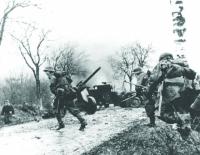
German troops advancing past abandoned American equipment.
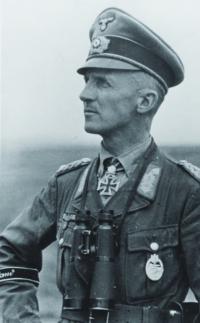
Gen. Baron Hasso-Eccard von Manteuffel, cmdr. 5th Panzerarmee, wearing Knight’s Cross.
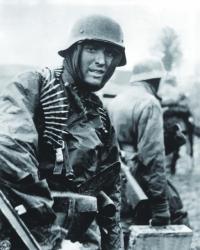
A German machine gunner marching through the Ardennes in Dec. 1944.
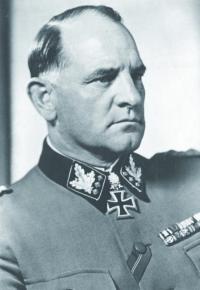
“Sepp” Dietrich, cmdr. 6th SS Panzerarmee, wearing Knight’s Cross with Oak Leaves and Swords.
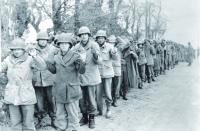
U.S. POWs on 22 December 1944.
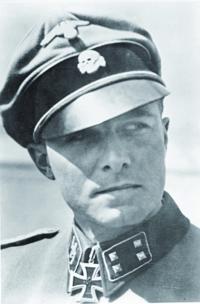
Joachim Peiper, wearing Knight’s Cross.
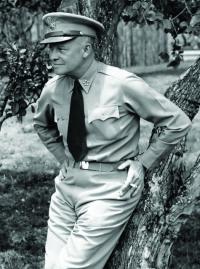
Gen. of the Army Dwight D. Eisenhower.
The Battle of the Bulge, also known as the Ardennes Campaign, was fought from December 16, 1944 to January 25, 1945. The idea behind the German Offensive was to capture the Port of Antwerp, thus depriving the Allies of a very critical seaport resulting in the Allies being pushed out of this area of operation. The result would be a very big loss and, it was hoped, cause the British and Americans to sign a separate peace agreement.
The Germans were having a difficult time and losing ground in the East. By defeating the Allies, in the West, they could then focus on the Soviets. As such, the German High Command developed several plans, one of which included a Blitzkrieg through the Ardennes, which was not heavily defended. The attack was approved by Hitler and assigned to Field Marshals Walter Model and Gerd von Rundstedt. Both thought this offensive was too ambitious and tried to limit the attack and stop at the Meuse River, to no avail.
To carry out the objective, SS-Oberstgruppenführer Josef “Sepp” Dietrich's 6th SS Panzerarmee would attack from the North and take the port city of Antwerp. At the same time, General Baron Hasso-Eccard von Manteuffel's 5th Panzerarmee would attack the center, taking Brussels, while General Erich Brandenberger's 7th Army would advance from the South in order to protect the flank.
With all the players in place, under radio silence, and using the cover of adverse weather conditions, the Germans began their advance. Additionally, the Germans had a unit which spoke fluent English and dressed in captured GI uniforms infiltrating the American lines. The Allies later discovered this plan and captured most of the infiltrators, who were summarily executed as spies. Their operation only partially succeeded.
Supreme Allied Commander, General Dwight D. Eisenhower, believed the Ardennes sector was a quiet area and was blind to the German offensive that was beginning. In fact, he believed the German troop movements were the Germans maneuvering into a defensive campaign. Further, the American troops in the Ardennes sector were comprised of untested soldiers. The area was being used for recovery and training.
On December 16, the big guns of “Sepp” Dietrich's 6th SS Panzerarmee opened fire and its men attacked. Elsenborn Ridge and Losheim Gap were the objectives to ultimately advance to the Belgian city of Liège, which currently has a population of 195,000. The American 2nd and 99th Infantry Divisions, commanded by Walter M. Robertson and Walter Lauer, defended these positions, fighting with uncommon valor and Dietrich was forced to commit his tanks.
In the center, General von Manteuffel's 5th Panzerarmee opened a gap through the 28th and 106th Infantry Divisions, commanded by Norman D. Cota and Herbert T. Perrin, capturing two full American regiments of the 106th. It was one of the largest mass surrenders in American military history. This was the so called “Bulge” in the American lines, putting the town of St. Vith in danger of capture. The 5th Panzerarmee’s advance was slowed, giving the 101st Airborne Division time to be moved, by truck, to the crossroads town of Bastogne. The weather was horrible with heavy snow storms and extremely low temperatures, causing all kinds of problems for men and equipment, not to mention that American air power was grounded and of no help to the Americans.
In the meantime General Brandenberger’s 7th Army was stopped after a 4-mile advance by the American VIII Corps, commanded by J. Lawton (“Lighting Joe”) Collins. On the 17th, General Eisenhower realized this was a major German offensive and began rushing reinforcements to the area.
In the early morning hours of December 17, Colonel Dr. Baron Friedrich August von der Heydte, despite the weather, dropped his unit, by parachute, to attempt the capture of the crossroads near Malmédy, a Belgian town of lees than 10,000. His paratroopers scattered to the four winds and were ineffective and fought as a guerilla force. It was the last German paratroop operation of the war. Later in the day, Colonel Joachim Peiper’s Kampfgruppe Peiper captured and executed 150 American POWS at Malmédy, to be forever known as the “Malmedy Massacre.” Pieper, being the tip of the spear in the attack, captured Stavelot and moved toward Stoumont.
Pieper met heavy resistance and the American forces retook Stavelot, The SS colonel´s unit ran out of fuel and his forces fought on foot.
Brigadier General Bruce Clarke fought a holding action at St. Vith, but was driven back by the 5th Panzer Division, commanded by Olympic equestrian gold medal winner Rudolf Lippert. This collapse of the American lines led to the encirclement of the 101st Airborne Division and the 10th Armored Division Combat Command B at Bastogne.
Eisenhower met with his commanders at Verdun on the 19th. Seizing upon the opportunity to counterattack and catch the Germans in the open, Eisenhower asked General George S. Patton, Jr. how long it would take to get his armor to Bastogne. Patton had anticipated these orders and had already begun to move. He responded, “48 hours!”
The 101st, in the now surrounded Bastogne, fought numerous engagements and attacks in the worst possible winter weather and held the Germans at bay. The German Commander, General Baron Heinrich von Lüttwitz, sent a representative, under a white flag, to see General Anthony McAuliffe in Bastogne to demand the American Forces surrender. The message was delivered to McAuliffe, who famously sent his reply back with one simple word - "NUTS!" Confused and infuriated, the German officer returned to his lines.
Meanwhile British Field Marshal Bernard Montgomery was shifting his forces to hold the Germans at the Meuse River, the Allied resistance was gaining strength, the weather was beginning to clear and American Air Power was prepping to join the fight. The German advance, running low on fuel, began to fail. The farthest German advance was 10 miles from the Meuse River, which folded and stopped on the 24th of December.
General von Manteuffel’s 5th Panzerarmee was running low on fuel and under constant counterattacks. The General requested permission to withdraw, but his request was emphatically denied by Hitler on the 24th.
Patton broke through, on the 26th, to Bastogne, and was ordered to press North in early January. Field Marshal Montgomery was ordered South to meet at Houffalize to trap the German forces. While this operation was successful, delays allowed the Germans to escape, but they had to abandon their vehicles and equipment.
Even though their offensive was falling apart, the Germans were desperate to keep it going and another major offensive was launched by the Luftwaffe on January 1, 1945. At the same time a ground offensive was launched in Alsace. The US 7th Army, commanded by Lt. Gen. Alexander M. Patch, Jr., fell back to the Moder River, where it contained and halted the attack. The German offensive at the Battle of the Bulge was over.
If the heroics of the men fighting the Battle of the Bulge could be cataloged, this article would be never ending. The Engineering Units with two or three men under heavy German fire blew bridges within sight of German armor, forcing delays in the German advance. Soldiers had to urinate on their weapons that were frozen and inoperable. Weapons were constantly being broken down and heated over fires to remain functional. With the “Malmedy Massacre” fresh on their minds German snipers would lie in their hides killing GIs until they ran out of ammunition then come out and surrender, smiling at their captors, knowing they'd be treated well. Their smiles were quickly dispatched. It was reported that on Christmas Eve there were soldiers on both sides who met in peace and some even sending Christmas greetings by messenger without a shot being fired, but on Christmas morning, once again, began the acts of war. In the battle, approximately 84,000 troops were either killed, wounded, captured, or missing on both sides. The Battle of the Bulge will forever live as one the greatest battles ever fought in World War II.
God Bless America and the men and women who fought, now living and those dead, that kept this Nation free.
NEXT: YALTA
«Go back to the previous page.






